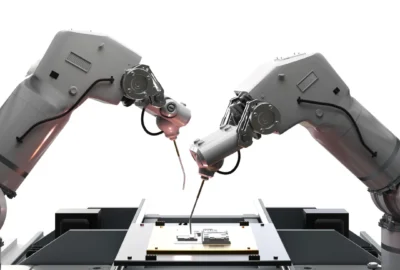Robotic Automation has crossed the line from experimental to essential. In 2026, it’s no longer a futuristic buzzword whispered in innovation meetings. It’s a practical growth engine that Founders and COOs use to scale operations, control costs, and free up human talent for creative work.
If you run a company, this guide is for you. You’ll learn what Robotic Automation truly means today, how to implement it without chaos, what kind of ROI to expect, and how the smartest Founders are building their operational edge through bots, not burnout.
The State of Robotic Automation in 2026
Robotic Automation has matured into a critical layer of the business stack. It sits quietly behind CRMs, ERPs, and analytics dashboards—moving data, triggering workflows, and cleaning up inefficiencies that human teams never have time to fix.
What’s changed in 2026 is speed. The cost of deploying bots has dropped by nearly 40% compared to three years ago. Platforms like UiPath, Automation Anywhere, and Microsoft Power Automate now allow Founders to launch pilots within weeks. Even small companies can scale automation without hiring an army of developers.
For COOs, Robotic Automation has become the new infrastructure. It connects departments, accelerates cycle times, and replaces friction with flow.
Key Takeaway: Robotic Automation in 2026 is not about robots replacing people. It’s about people designing robots to handle what slows them down.
Transform your Business Operations.
Why Founders Can’t Ignore Robotic Automation
Founders love leverage. Robotic Automation is leverage at scale. It’s the ability to run repetitive processes at zero fatigue, zero delay, and near-zero cost.
A Founder who automates 10 hours of work per week gains 520 hours per year—without adding a single salary. Multiply that by ten employees, and you’ve created the equivalent of an extra full-time team purely through automation.
Robotic Automation also sharpens decision making. When tasks like data cleanup, lead qualification, or financial reconciliation run in the background, leaders can focus on growth and product direction instead of firefighting operations.
But here’s the real reason Founders are investing heavily: predictability. Bots don’t forget. They don’t delay. They don’t ask for sick days.
The COO’s View: Turning Automation Into Infrastructure
While Founders dream in growth, COOs think in systems. To a COO, Robotic Automation is not a tool—it’s an operational backbone.
A strong COO understands that the success of Robotic Automation depends on structure. Every automated process must have a clear owner, an exception plan, and a metric to prove value.
The smart COOs of 2026 treat their bots like employees: they get onboarding, documentation, monitoring, and performance reviews. The result is a reliable digital workforce that scales without breaking.
Understanding What Robotic Automation Really Is
Forget the sci-fi image of humanoid robots. Robotic Automation is software that mimics repetitive human actions—like entering data, sending emails, updating spreadsheets, or pulling reports.
Here’s a simple comparison:
| Task Type | Human Effort | Robotic Automation Effort | Result |
|---|---|---|---|
| Data entry | Manual typing | Automated script | 90% faster |
| Invoice matching | Cross-checking | Automated rule set | 99% accuracy |
| Report generation | Spreadsheet formula | Bot workflow | Instant delivery |
| Customer updates | Email follow-ups | CRM-triggered automation | Consistent responses |
What matters most is not the task—it’s the repeatability. Anything that follows a pattern can be automated.
How Founders Should Approach Robotic Automation
The worst mistake Founders make is treating automation like a side project. It should be a core business initiative tied directly to measurable outcomes.
Start with clarity.
Ask one question: “What is the single process that wastes the most productive hours?”
From there, create a simple pilot plan:
- Identify one repetitive process.
- Measure the time it currently takes.
- Automate it with a small Robotic Automation pilot.
- Measure again.
- Present the result as a case for scaling.
When Founders follow this playbook, buy-in from investors and teams becomes natural. The numbers speak louder than hype.
COOs: Making Robotic Automation Work Daily
COOs must own the operational reality of Robotic Automation. Every automation needs guardrails. That includes exception management, scheduling, monitoring, and security.
Here’s how a COO might design a daily routine for Robotic Automation:
| Time | Action | Responsible | Output |
|---|---|---|---|
| 9 AM | Check overnight bot logs | Operations Analyst | Error summary |
| 10 AM | Review failed runs | Automation Lead | Fix plan |
| 1 PM | Deploy scheduled bots | IT Ops | Updated metrics |
| 4 PM | Report on success rate | COO | Daily dashboard update |
This structure ensures accountability. It keeps Robotic Automation transparent instead of mysterious.
Key Takeaway: Automation without governance is chaos. Governance without automation is stagnation.
Transform your Business Operations.
Build, Buy, or Blend? Choosing Your Robotic Automation Stack
The market for Robotic Automation tools is huge, but Founders should focus on fit, not flash.
| Option | Speed to Deploy | Cost | Skill Required | Best For |
|---|---|---|---|---|
| Low-code platforms (Zapier, Power Automate) | Fast | Low | Beginner | Startups and small teams |
| Enterprise platforms (UiPath, Automation Anywhere) | Moderate | Medium-High | Intermediate | Mid to large organizations |
| Open-source tools (TagUI, Robocorp) | Slower | Low | Advanced | Tech-savvy teams |
| Hybrid approach | Moderate | Flexible | Varies | Companies scaling across functions |
The rule of thumb:
- Founders want quick wins—start low-code.
- COOs want control—go enterprise.
- Engineers want freedom—build custom.
Measuring ROI From Robotic Automation
Automation should never be “just cool.” It must prove its worth in numbers.
Here’s a simple ROI breakdown to help Founders justify the investment:
| Metric | Formula | Example Value |
|---|---|---|
| Hours saved | Hours automated × employee rate | 400 × $30 = $12,000/month |
| Cost of platform | Fixed monthly fee | $2,500 |
| Implementation | Amortized setup | $1,500 |
| Net savings | Labor savings – total costs | $8,000/month |
That’s a 320% ROI in the first 90 days if implemented right.
Security and Governance in RPA
Automation without security is risk disguised as progress. Bots often handle sensitive data, invoices, and customer information.
COOs must apply strict controls:
- Use role-based access for every bot.
- Rotate credentials monthly.
- Log every bot action.
- Encrypt all data at rest and in transit.
Founders should demand visibility. Ask for dashboards showing every task your Robotic Automation system runs and every exception it encounters.
How to Scale RPA Across a Company
Once the first pilot succeeds, it’s time to scale—carefully.
Here’s a simple 16-week rollout model:
| Phase | Weeks | Goal | Output |
|---|---|---|---|
| Planning | 1–2 | Select process and KPIs | Process map |
| Design | 3–4 | Define workflow | Bot spec |
| Build | 5–8 | Develop and test | Working bot |
| Pilot | 9–10 | Live run | Data results |
| Optimize | 11–12 | Fix errors | Stable version |
| Scale | 13–16 | Add 2–3 new processes | Expanded automation |
By the end of this cycle, Founders can present quantifiable ROI and COOs can document the new operational framework.
The Human Side of Robotic Automation
People fear automation when it’s invisible. Transparency removes that fear.
When Founders explain that Robotic Automation removes boring tasks, not jobs, they build trust. When COOs train teams to manage bots instead of compete with them, they create collaboration.
Automation does not erase humans. It elevates them.
What Success Looks Like
Founders and COOs who get Robotic Automation right in 2026 share a few habits:
- They start small but measure aggressively.
- They document every automation as if it were a new hire.
- They review dashboards weekly and adapt fast.
- They make automation part of company culture.
Key Takeaway: The companies that scale best are not those with the most people, but those with the smartest systems.
Final Thoughts for Founders and COOs
Robotic Automation is the new competitive edge. It doesn’t just make operations efficient—it makes leadership more strategic. Founders gain focus. COOs gain control. Teams gain time to think.
The companies winning in 2026 are not guessing their way to growth. They’re automating their way there, one process at a time.
If you are a Founder, start your first pilot this quarter. If you are a COO, design the governance that keeps automation reliable. Because in 2026, Robotic Automation isn’t the future—it’s the framework of every successful company.
Transform your Business Operations.
Frequently Asked Questions About Robotic Automation for Business Leaders
What is robotic process automation (RPA)?
Robotic process automation (RPA) is software that automates repetitive digital tasks such as data entry, report generation, or invoice processing. It mimics human actions on computers but performs them faster and without errors.
How can automation help founders and COOs?
Automation helps leaders scale faster by freeing teams from repetitive work. It improves accuracy, reduces costs, and gives executives more time to focus on strategy, innovation, and growth.
What business processes can be automated with RPA?
Common use cases include customer onboarding, billing, payroll, data migration, analytics reporting, and compliance documentation. If a task is rule-based and repetitive, it can usually be automated.
How does RPA improve efficiency?
It eliminates manual data handling, reduces human errors, and accelerates workflows. This leads to faster turnaround times, lower operational costs, and consistent process performance.
Is RPA only for large enterprises?
No. Many small and mid-sized businesses now use lightweight automation tools that integrate with existing software. Cloud-based RPA platforms make it accessible without heavy infrastructure costs.
How do you know if your company is ready for automation?
You’re ready when manual work slows growth, errors keep recurring, or your team spends too much time on low-value tasks. A simple process audit can reveal the best automation opportunities.
What is the ROI of robotic automation?
Most businesses see ROI within 6 to 12 months. Savings come from reduced labor hours, faster operations, and improved accuracy that prevents costly rework.
Does automation replace human jobs?
Not directly. It replaces tasks, not people. Automation allows teams to focus on creative, strategic, and customer-facing work while software handles the repetitive, rules-based tasks.
How secure is robotic automation?
Modern RPA tools follow strict data security standards, encryption, and audit trails. The key is to work with trusted vendors and maintain proper access controls within your systems.
How can founders start implementing automation?
Begin by mapping repetitive tasks, setting measurable goals, and running a pilot project. From there, scale automation across departments like HR, finance, and operations for maximum impact.
Featured Image: Generated From Canva



